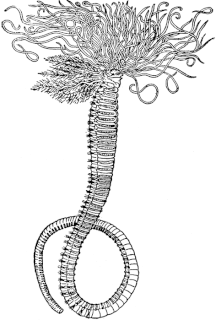
Spirobranchus giganteus, commonly known as the Christmas tree worm, is a tube-building polychaete worm belonging to the family Serpulidae.
Hydroides is a genus of tube-forming serpulid worms found on submerged saltwater rocks, shells, and boats in many coastal areas around the world.

Sabellidae, or feather duster worms, are a family of marine polychaete tube worms characterized by protruding feathery branchiae. Sabellids build tubes out of a tough, parchment-like exudate, strengthened with sand and bits of shell. Unlike the other sabellids, the genus Glomerula secretes a tube of calcium carbonate instead. Sabellidae can be found in subtidal habitats around the world. Their oldest fossils are known from the Early Jurassic.

Pomatoceros triqueter is a species of tube-building annelid worm in the class Polychaeta. It is common on the north eastern coasts of the Atlantic Ocean and in the Mediterranean Sea.

Spirorbis borealis is a sedentary marine polychaete worm in the Serpulidae family. It is commonly called the sinistral spiral tubeworm and is the type species of the genus Spirorbis.

Sabellastarte spectabilis is a species of benthic marine polychaete worm in the Sabellidae family. It is commonly known as the feather duster worm, feather duster or fan worm. It is native to tropical waters of the Indo-Pacific but has spread to other parts of the world. It is popular in aquariums because of its distinctive appearance and its ability to remove organic particles and improve water quality.

Eupolymnia nebulosa is a species of sedentary marine polychaete worm in the Terebellidae family. It builds a tube of slime under stones or large shells on soft substrates on the lower shore and down to depths of about 500 metres.

Chaetopterus variopedatus is a species of parchment worm, a marine polychaete in the family Chaetopteridae. It is found worldwide. However, recent discoveries from molecular phylogeny analysis show that Chaetopterus variopedatus sensu Hartman (1959) is not a single species.

Amphitrite ornata or ornate worm, is a species of marine polychaete worm in the family Terebellidae.

Cirratulus cirratus is a species of marine polychaete worm in the family Cirratulidae. It occurs in the littoral and sub-littoral zones of the Atlantic Ocean.

Cirratulidae is a family of marine polychaete worms. Members of the family are found worldwide, mostly living in mud or rock crevices. Most are deposit feeders, but some graze on algae or are suspension feeders.

Lanice conchilega, commonly known as the sand mason worm, is a species of burrowing marine polychaete worm. It builds a characteristic tube which projects from the seabed, consisting of cemented sand grains and shell fragments with a fringe at the top.
Abarenicola pacifica or the Pacific lugworm is a large species of polychaete worm found on the west coast of North America and also in Japan. The worms live out of sight in burrows under the sand and produce casts which are visible on the surface.

Lagis koreni, commonly known as the trumpet worm, is a species of marine polychaete worm found in European waters. It lives within a narrow conical tube made of grains of sand and shell fragments.

Serpula vermicularis, known by common names including the calcareous tubeworm, fan worm, plume worm or red tube worm, is a species of segmented marine polychaete worm in the family Serpulidae. It is the type species of the genus Serpula and was first described by Carl Linnaeus in his 1767 12th edition of Systema Naturae. It lives in a tube into which it can retract.

Sabellaria spinulosa is a species of marine polychaete worm in the family Sabellariidae, commonly known as the Ross worm. It lives in a tube built of sand, gravel and pieces of shell.
Neosabellaria cementarium is a species of marine tube worm in the family Sabellariidae, perhaps better known by its previous name, Sabellaria cementarium. It is found in the North Pacific Ocean.

Polydora ciliata is a species of annelid worm in the family Spionidae, commonly known as a bristleworm. It is a burrowing worm and is found in the northeastern Atlantic Ocean and some other parts of the world.
Hydroides elegans is a species of tube-forming serpulid worms. It is a harbour fouling invasive species, in contrast with Hydroides norvegica with which it is sometimes confused.
Hydroides ezoensis is a species of tube-forming annelid worm in the family Serpulidae. It is native to the temperate northern Pacific and the central Indo-Pacific and is found in the intertidal zone and on submerged rocks, shells, pilings, jetties and boats.














